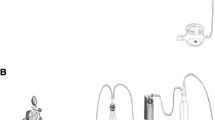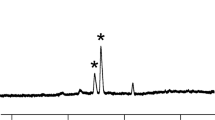Abstract
Compounds from the metasternal and Brindley's glands of the blood-sucking bug, Triatoma infestans, were identified by solid phase microextraction (SPME) and gas chromatography-mass spectrometry. Volatile compounds released by adult bugs during copulation or after mechanical disturbance were also characterized. Six compounds were identified and found consistently in all samples from metasternal glands. The most abundant were 3-pentanone, 2-methylbutanol, 3-pentanol, and an unidentified compound. The metasternal gland blends did not differ qualitatively between sexes. Compounds found in Brindley's glands were short chain acids, alcohols, esters, and a ketone with no qualitative differences between sexes. Isobutyric acid was the main component of this blend, and two new confirmed compounds were described as products of these glands: 2-butanone and 2-methylbutyric acid. 3-Pentanone was collected from the headspace over 33% of the copulating pairs of T. infestans. Volatiles found in the headspace of disturbed T. infestans adults included short-chain fatty acids, alcohols, esters, and ketones, with no qualitative differences between sexes. Both types of glands apparently discharge their contents after disturbance. However, most of the volatiles released by bugs after disturbance came from Brindley's glands. The locomotor activity of fourth instars increased significantly after stimulation with the odors emitted by disturbed adults, as compared with larvae stimulated by the odor of undisturbed adults or by clean air. We also studied the directional behavioral response of fifth instars to the disturbance scent in a locomotion compensator. Larvae exposed to volatiles released by disturbed adults walked away from the direction of the odor. The results suggest that this blend or part of it functions as an alarm pheromone for T. infestans. We suggest that the metasternal glands of this species are involved both in the sexual and the alarm contexts, and that the Brindley's glands probably have both alarm and defensive roles.







Similar content being viewed by others
References
Arthur, C. L. and Pawliszyn, J. 1990. Solid phase microextraction with thermal desorption using fused silica optic fibers. Anal. Chem. 62:2145–2148.
Baldwin, W. F., Knight, A. G., and Lynn, K. R. 1971. A sex pheromone in the insect Rhodnius prolixus (Hemiptera: Reduviidae). Can. Entomol. 103:18–22.
Barrozo, R. B., Manrique, G., and Lazzari, C. R. 2003. The role of water vapour in the orientation behaviour of the blood-sucking bug Triatoma infestans (Hemiptera, Reduviidae). J. Insect Physiol. 49:315–321.
Barth, R. 1980. A glandula ectodermal do aparelho copulador do Triatoma infestans. Mem. Inst. Oswaldo Cruz 75:119–124.
Blum, M. S. 1996. Semiochemical parsimony in the Arthropoda. Annu. Rev. Entomol. 41:353–374.
Carayon, J., Usinger, R. L., and Wygodzinsky, P. 1958. Notes on the higher classification of the Reduviidae, with the description of a new tribe of the Phymatinae. Rev. Zool. Bot. Afr. 57:256–281.
Cruz López, L., Morgan, E. D., and Ondarza, R. N. 1995. Brindley's gland exocrine products of Triatoma infestans. Med. Vet. Entomol. 9:403–406.
Cruz López, L., Malo, E. A., Rojas, J. C., and Morgan, E. D. 2001. Chemical ecology of triatomine bugs: Vectors of chagas disease. Med. Vet. Entomol. 15:351–357.
Dias, J. C. P., Silveira, A. C., and Schofield, C. J. 2002. The impact of chagas disease control in Latin America—A review. Mem. Inst. Oswaldo Cruz 97:603–612.
Eisner, T. 2004. For Love of Insects. Belknap Press, Harvard University Press, Cambridge, MA.
Espínola, H. N. 1966. Nota sobre diferenças sexuais em formas imaturas de Triatominae (Hemiptera, Reduviidae). Rev. Bras. Biol. 26:263–267.
Fontán, A., Audino, P. G., Martinez, A., Alzogaray, R. A., Zerba, E. N., Camps, F., and Cork, A. 2002. Attractant volatiles released by female and male Triatoma infestans (Hemiptera: Reduviidae), a vector of chagas disease: Chemical analysis and behavioral bioassay. J. Med. Entomol. 39:191–197.
Games, D. E., Schofield, C. J., and Staddon, B. W. 1974. The secretion from Brindley's scent gland in Triatominae. Ann. Entomol. Soc. Am. 67:820.
Giblin-Davis, R. M., Oehlschlager, A. C., Perez, A., Gries, G., Gries, R., Weissling, T. J., Chinchilla, C. M., Peña, J. E., Hallett, R. H., Pierce, H. D. Jr., and González, L. M. 1996. Chemical and behavioral ecology of palm weevils (Curculionidae: Rhynchophorinae). Fla. Entomol. 79:153–167.
Guerenstein, P. G. 1999. Sensory and behavioural responses of Triatoma infestans to host and conspecific odours. PhD thesis, Université de Neuchâtel, Switzerland, p. 137.
Guerenstein, P. G. and Guerin, P. M. 2001. Olfactory and behavioural responses of the blood-sucking bug Triatoma infestans to odours of vertebrate hosts. J. Exp. Biol. 204:585–597.
Guerenstein, P. G. and Guerin, P. M. 2004. A comparison of volatiles emitted by adults of three triatomine species. Entomol. Exp. Appl. 111:151–155.
Hack, W. H., Ricciardi, A. I., Oscherov, B., and Olivetti, de B. 1980. Composition of the secretion of Brindley's gland in Triatominae. Medicina (B. Aires) 40 Suppl. I:178–180.
Hilker, M. and Schulz, S. 1994. Composition of larval secretion of Chrysomela lapponica (Coleoptera, Chrysomelidae) and its dependence on host plant. J. Chem. Ecol. 20:1075–1093.
Juárez, P. and Brenner, R. R. 1981. Bioquímica del ciclo evolutivo del Triatoma infestans (vinchuca). V. Emisión de ácidos grasos volátiles. Acta Fisiol. Lat.-Am. 31:113–117.
Kälin, M. and Barrett, F. M. 1975. Observations on the anatomy, histology, release-site, and function of Brindley's gland in the blood-sucking bug Rhodnius prolixus. Ann. Entomol. Soc. Am. 68:126–134.
Kanehisa, K. and Kawazu, K. 1982. Fatty-acid components of the defensive substances in acid secreting carabid beetles. Appl. Entomol. Zool. 17:460–466.
Kennedy, J. S. 1977. Olfactory responses to distant plants and other odor sources, pp. 6791, in H. H. Shorey and J. J. McKelvey (eds.). Chemical Control of Insect Behavior. Wiley-Interscience, New York.
Manrique, G. and Lazzari, C. R. 1994. Sexual behaviour and stridulation during mating in Triatoma infestans (Hemiptera: Reduviidae). Mem. Inst. Oswaldo Cruz 89:629–633.
Manrique, G. and Lazzari, C. R. 1995. Existence of a sex pheromone in Triatoma infestans (Hemiptera: Reduviidae): I. Behavioural evidence. Mem. Inst. Oswaldo Cruz 90:645–648.
Pattenden, G. and Staddon, B. W. 1972. Identification of iso-butyric acid in secretion from Brindley's scent glands in Rhodnius prolixus (Heteroptera: Reduviidae). Ann. Entomol. Soc. Am. 65:1240–1241.
Rochat, D., Ramirez-Lucas, P., Malosse, C., Aldana, R., Kakul, T., and Morin, J. P. 2000. Role of solid-phase microextraction in the identification of highly volatile pheromones of two Rhinoceros beetles Scapanes australis and Strategus aloeus (Coleoptera, Scarabaeidae, Dynastinae). J. Chromatogr. A 885:433–444.
Rojas, J. C., Rios-Candelaria, E., Cruz López, L., Santiesteban, A., Bond-Compean, J. G., Brindis, Y., and Malo, E. A. 2002. A reinvestigation of Brindley's gland exocrine compounds of Rhodnius prolixus (Hemiptera: Reduviidae). J. Med. Entomol. 39:256–265.
Rossiter, M. and Staddon, B. W. 1983. 3-Methyl-2-hexanone from the triatominae bug Dipetalogaster maximus (Uhler) (Heteroptera; Reduviidae). Experientia 39:380–381.
Schofield, C. J. 1979. Demonstration of isobutyric acid in some triatomine bugs. Acta Trop. 36:103–105.
Schofield, C. J. and Upton, C. P. 1978. Brindley's scent-glands and the metasternal scent-glands of Panstrongylus megistus (Hemiptera, Reduviidae, Triatominae). Rev. Bras. Biol. 38:665–678.
Staddon, B. W. 1983. The scent glands of Heteroptera. Adv. Insect Physiol. 14:131–157.
Ward, J. P. 1981. A comparison of the behavioural responses of the haematophagous bug, Triatoma infestans to synthetic homologues of two naturally occurring chemicals (n- and isobutyric acid). Physiol. Entomol. 6:325–329.
Weirauch, C. 2003. Glandular areas associated with the male genitalia in Triatoma rubrofasciata (Triatominae, Reduviidae, Hemiptera) and other Reduviidae. Mem. Inst. Oswaldo Cruz 98:773–776.
Weirauch, C. 2004. Distribution of a sternal glandular area among female Reduviidae (Heteroptera) with discussion of a possible pheromonal function. Dtsch. Entomol. Z. 51:3–6.
WHO (World Health Organization) 1999. Chagas disease, Chile—Interruption of transmission. WHO, Wkly. Epidemiol. Rec. 74:9–11.
Zar, J. H. 1984. Biostatistical Analysis, 2nd ed., Prentice-Hall, London.
Acknowledgments
The authors are indebted to Prof. K.-E. Kaissling (Max Planck Institut für Verhaltensphysiologie, Seewiesen, Germany) for suggestions and improvements in the manuscript, and to C. Reisenman (University of Arizona) for critically reading the manuscript. We thank G. Aulin-Erdtman, Stockholm, Sweden, G. Flores, New York, USA, and M. Melcón, Buenos Aires, Argentina, for corrections of the English. We wish to thank S. Minoli and R. Barrozo for advice on behavioral experiments, and the staff members of our laboratories for many fruitful discussions. We thank T. C. Insausti (Universidad de Buenos Aires, Argentina) for guidance to A. Vitta in the dissection of glands. We are also indebted to P. Guerenstein (University of Arizona) for his advice and criticism, and to M.C. Rodriguez and G. Vélez (both from Universidad de Buenos Aires, Argentina) for the provision of some chemical standards. This investigation received financial support from the UNDP/World Bank/WHO Special Programme for Research and Training in Tropical Diseases (TDR), CAPES-SETCIP, PRONEX, PAPES, FIOCRUZ, Swedish International Development Cooperation Agency (SIDA), CONICET and Universidad de Buenos Aires.
Author information
Authors and Affiliations
Corresponding author
Rights and permissions
About this article
Cite this article
Manrique, G., Vitta, A.C.R., Ferreira, R.A. et al. Chemical Communication in Chagas Disease Vectors. Source, Identity, and Potential Function of Volatiles Released by the Metasternal and Brindley's Glands of Triatoma infestans Adults. J Chem Ecol 32, 2035–2052 (2006). https://doi.org/10.1007/s10886-006-9127-7
Received:
Revised:
Accepted:
Published:
Issue Date:
DOI: https://doi.org/10.1007/s10886-006-9127-7




